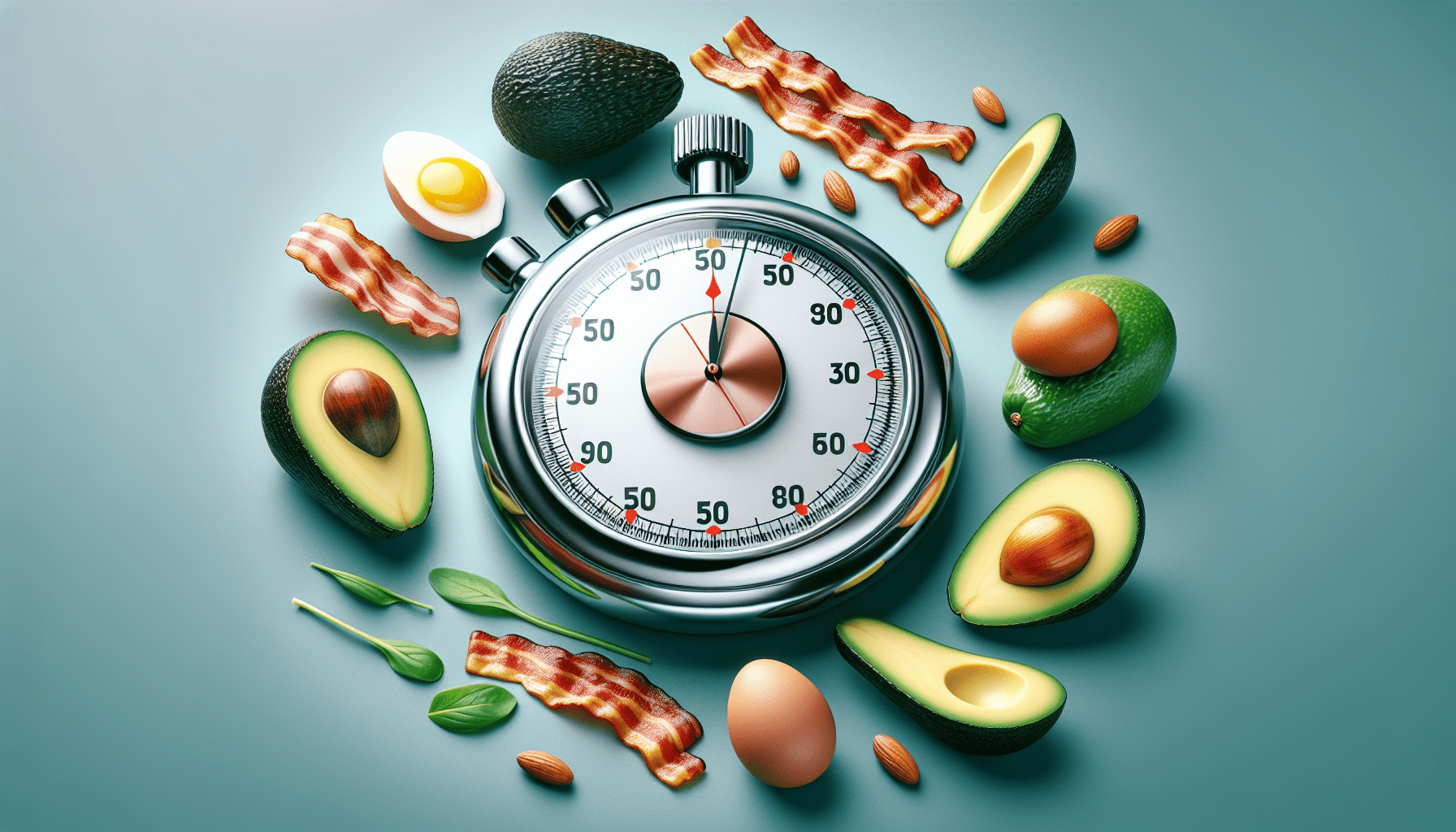Have you ever wondered how long it actually takes to start burning fat on a keto diet? Embarking on a ketogenic journey can be an exciting but sometimes overwhelming choice. The promise of increased energy, substantial weight loss, and overall better health makes it appealing, but understanding the process and timeframe can help set your expectations and keep you motivated.
Understanding the Basics of the Keto Diet
The ketogenic diet, often referred to simply as keto, is a high-fat, moderate-protein, and low-carbohydrate diet. When you drastically reduce your carbohydrate intake, your body is forced to look for alternative energy sources. This is where fat comes into play.
How Keto Works: The Science
At its core, the keto diet aims to push your body into a state called ketosis. Normally, your body relies on glucose (sugar) from carbs as its primary energy source. When carbs are in short supply, your liver breaks down fat into molecules called ketones, which your body then uses for energy. This process encourages fat burning and can lead to weight loss.
Here’s a simple breakdown:
| Macronutrient | Traditional Diet | Keto Diet |
|---|---|---|
| Carbohydrates | 45%-65% | 5%-10% |
| Protein | 10%-35% | 15%-25% |
| Fat | 20%-35% | 70%-80% |
The Initial Transition: The Keto Flu
Before you start seeing the benefits of fat burning, there’s often a transition period. During this time, you might experience what’s known as the “keto flu.” This isn’t an actual flu, but rather a set of symptoms that can make you feel under the weather as your body adapts to its new fuel source.
Symptoms of Keto Flu
- Fatigue: As your body shifts from burning glucose to burning fat, you might feel unusually tired.
- Headaches: Changes in blood sugar levels can sometimes lead to headaches.
- Nausea: Your digestive system may take some time to adjust.
- Irritability: Mood swings are not uncommon as your body goes through this metabolic shift.
These symptoms typically last about a week, although everyone’s experience can vary. Staying hydrated, getting enough sleep, and ensuring your electrolyte intake (sodium, potassium, and magnesium) is sufficient can mitigate some of these symptoms.

When Do You Start Burning Fat?
You’re probably eager to know when the fat-burning magic begins. Generally speaking, it can take anywhere from 2 to 7 days to enter ketosis if you maintain the appropriate dietary restrictions. This timeframe can vary, however, based on several factors, including your metabolism, level of physical activity, and overall health.
Signs You’re in Ketosis
To truly know if you’ve entered ketosis, you can use at-home testing kits that measure the presence of ketones in your urine, breath, or blood. Additionally, there are some signs your body will give you:
- Increased Urination: You may find yourself needing to urinate more often, which is a sign your body is excreting ketones.
- Dry Mouth: This increased urination can also contribute to a parched feeling.
- Reduced Hunger: Ketosis can lead to a natural reduction in appetite.
- Energy Boosts: After the initial fatigue passes, many people report feeling more energetic.
How Do Keto Supplements Help?
Keto supplements can also play a significant role in your fat-burning journey. Exogenous ketones, MCT oil, and electrolytes are common supplements that can facilitate the transition and maintain ketosis.
Exogenous Ketones
These are external sources of ketones that can mimic the state of ketosis. Taking exogenous ketones can help maintain higher ketone levels in your blood, thus aiding in quicker fat burning.
MCT Oil
Medium-chain triglycerides (MCTs) are fats that are more easily absorbed and converted into ketones by your liver. Adding MCT oil to your diet can provide an immediate source of energy and support your ketogenic state.
Electrolytes
As mentioned earlier, maintaining balanced electrolytes can help alleviate keto flu symptoms and sustain energy levels. Sodium, potassium, and magnesium are the key electrolytes you should monitor.
The Weight Loss Timeline: What to Expect
So, you’ve navigated through the initial phase, started taking supplements to keep your energy up, and now you’re eager to see some results. It’s important to have realistic expectations about the timeline for weight loss on a keto diet.
Short-term Weight Loss
In the first 1-2 weeks, you might see a significant drop on the scale. This is mostly water weight. As your body depletes its glycogen stores (which bind to water), you lose that water weight. Some people can lose up to 10 pounds in this early phase.
Long-term Weight Loss
After the initial period, weight loss tends to stabilize at a slower but steady rate. This long-term weight loss comes from burning stored fat and can range from 1 to 2 pounds per week, depending on individual factors such as age, sex, activity level, and metabolic health.
Here’s what you can generally expect:
| Time Frame | Expected Weight Loss |
|---|---|
| 1-2 weeks | 2-10 pounds (mostly water weight) |
| 3-8 weeks | 1-2 pounds per week (steady fat loss) |
| 2-6 months | Plateaus at intervals, average 1-2 pounds per week |
| 6+ months | Varies widely; dependent on adherence and lifestyle |

Factors Influencing Fat Burning on Keto
Even though the ketogenic diet is effective, several factors can influence how quickly and efficiently you burn fat.
Metabolism
Your metabolic rate is a significant factor. People with a faster metabolism will generally burn fat more quickly. Exercise can help boost this, so incorporating regular physical activity is beneficial.
Physical Activity
While the keto diet itself promotes fat burning, pairing it with regular exercise can expedite the process. Resistance training builds muscle, which in turn burns more calories even at rest. Cardio exercises can also increase your caloric deficit, contributing to faster fat loss.
Dietary Adherence
Sticking to the diet is crucial. Consuming more carbs than recommended can knock you out of ketosis, slowing your progress. You’ll need to stay diligent and make keto-friendly food choices consistently.
Stress and Sleep
Believe it or not, your lifestyle factors like stress and sleep greatly impact your fat-burning process. High stress levels can raise cortisol, a hormone that can lead to weight gain, especially around your midsection. Likewise, poor sleep can disrupt your metabolism and appetite, making it harder to stay on track.
Sustainable Keto: Avoiding Pitfalls
Maintaining a ketogenic lifestyle long-term can be challenging for some. Social obligations, cravings, and misinformation can lead to pitfalls that disrupt your progress.
Handling Social Situations
Eating out or attending events can be tricky, but it’s manageable with some planning. Many restaurants offer keto-friendly options. You can look for dishes high in protein and fat while avoiding those full of carbs.
Tackling Cravings
Cravings can set in, especially when you’re new to keto. Eating nutrient-dense foods that keep you full can help. Foods high in fiber, protein, and healthy fats are your best friends. Keto-friendly snacks, like cheese, nuts, and avocados, can also curb your cravings without ruining your progress.
Busting Myths
There’s a lot of misinformation about the keto diet. For example, some believe that eating a lot of bacon and butter will automatically lead to weight loss. While fats are a big part of the diet, nutrient quality matters. Focus on healthy fats (like avocado, olive oil, and fatty fish) rather than processed and trans fats.
Plateaus: What to Do When You Stop Burning Fat
Hitting a weight loss plateau can be frustrating, but it’s a natural part of the process. When this happens, your body is simply adjusting to your new weight and metabolism.
Adjusting Your Macros
You might need to tweak your macronutrient ratios. Sometimes, reducing protein slightly and increasing fat can help shake things up. Remember, the fewer carbs, the better your chances of staying in ketosis.
Re-evaluating Your Calorie Intake
As you lose weight, your daily caloric requirement decreases. Eating the same number of calories might now be a surplus rather than a deficit. Using a calorie tracking app can help you reassess your needs based on your new weight and activity level.
Incorporating Intermittent Fasting
Combining keto with intermittent fasting can provide an extra boost. This involves eating all your meals within a specific time frame, such as an 8-hour window, and fasting for the remaining hours of the day. This can help with fat loss and overall metabolic health.
Is Keto Right for You?
Before you begin your keto journey, it’s vital to consult with a healthcare provider, especially if you have underlying health conditions. Like any dietary plan, keto isn’t one-size-fits-all.
Monitoring Your Progress: Tools and Tips
To stay motivated, it’s important to track your progress, not just on the scale but through various other methods.
Ketone Testing
Using ketone strips or a blood ketone meter can give you an idea of whether you’re in ketosis. Aim for blood ketone levels between 0.5 to 3.0 mmol/L for nutritional ketosis.
Measuring Inches
Sometimes the scale doesn’t tell the whole story. Measuring your waist, hips, and other areas can show progress in inches, even if your weight plateaus.
Energy Levels and Mood
Keep a journal to track your energy levels and mood. Noting improvements here can be incredibly motivating and a sign that your body is adapting well to keto.
Regular Blood Work
Regular check-ups with your healthcare provider to monitor your cholesterol, triglycerides, and other markers can provide a comprehensive view of your health on keto.
Real-Life Success Stories
Hearing about others’ success on the keto diet can be incredibly motivating. Many people have transformed their lives through this high-fat, low-carb lifestyle, achieving not just weight loss but improved mental clarity and energy.
Rachel’s Journey
Rachel struggled with her weight for years. She tried various diets, but nothing seemed to stick. After starting keto, she initially experienced the keto flu but pushed through. Within two months, Rachel lost 15 pounds and noticed a significant increase in her energy levels. Her skin even cleared up, and she felt more focused. She attributes her success to strict adherence and incorporating intermittent fasting.
John’s Transformation
John was skeptical about giving up his favorite carb-heavy foods but felt desperate after years of yo-yo dieting. Remarkably, within the first week, John lost 6 pounds. By the third month, he dropped 30 pounds and found his workouts improved as he trained in a fasted state. He now considers keto more of a lifestyle than a diet.
Conclusion
Understanding how long it takes to start burning fat on a keto diet involves a mix of science, personal commitment, and lifestyle adjustments. While the initial adaptation phase can be challenging, the rewards of increased energy, better overall health, and sustained weight loss are well worth the effort. By setting realistic expectations, leveraging keto supplements, and continually monitoring your progress, you can successfully navigate your ketogenic journey.
So, are you ready to make the switch and see how quickly your body can start tapping into its fat reserves for energy? Your journey to burning fat on keto might just lead to a happier, healthier you.
Remember, everyone’s experience with keto is unique. Stay informed, stay committed, and you’ll find what works best for you. Happy ketoing!





